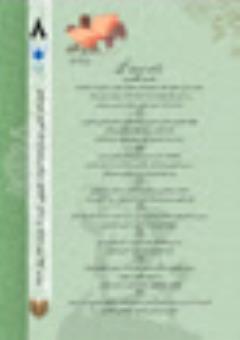کاربرد ان. ال. پی در حکایتهای گلستان سعدی با تأکید بر الگوی سوئیش (جابه-جایی)
محورهای موضوعی : ادبیات تطبیقی (فارسی- انگلیسی)
موسی زارع
1
![]() ,
کبری نودهی
2
*
,
کبری نودهی
2
*
![]() ,
محمد علی خالدیان
3
,
محمد علی خالدیان
3
1 - دانشجوی دکتری زبان و ادبیات فارسی، واحد گرگان ، دانشگاه آزاد اسلامی، گرگان، ایران.
2 - دانشیار گروه زبان و ادبیات فارسی، واحد گرگان، دانشگاه آزاد اسلامی، گرگان، ایران(نویسندۀ مسئول)
3 - استادیار زبان و ادبیات فارسی، واحد گرگان، دانشگاه آزاد اسلامی، گرگان، ایران
کلید واژه: ان. ال. پی, سعدی, گلستان, سوئیش (جابهجایی), عزّت نفس پایدار.,
چکیده مقاله :
الگوی سوئیش(جابهجایی) برای اوّلین¬بار در سال 1985 توسط ریچارد بندلر(روان¬شناس) و جان گریندر (زبان¬شناس)، بنیان-گذاران رشتة ان. ال. پی مطرح شد. بر اساس این الگو، رفتارهای خوشایند و هدفمند، با کمک منابع درون جایگزین رفتارهای ناخوشایند، اجباری و ناخواسته میشوند. در میان شاعران و نویسندگان بزرگ ادبیات فارسی هم¬سو با این شیوة درمان، سعدی استادی کارآزموده و عمل گراست که در گلستان با به¬کارگیری الگوی جابه¬جاییِ آنی، رفتارهای خوشایندِ شادی¬آفرین را با کمک منابع درون، جایگزین رفتارهای ناخوشایند و بازدارنده میکند. هدف تحقیق حاضر که با روش تحلیلی - توصیفی همة ابواب گلستان را مورد واکاوی قرار داده است، کاربرد ان. ال. پی در حکایتهای گلستان سعدی با تأکید بر الگوی سوئیش است. فرضیة پژوهش تأکیدی است بر این مسئله که هرکس برای خلقِ تصاویر خوشایند و نتایجی که دنبال میکند، منابع لازم و کافی در اختیار دارد و میتواند با شناخت دقیقِ محرّکهای مهاجم و مزاحم برای تولید تصاویر مثبت و نشاطآفرین از منابع درون اقدام کند و خود را از هرگونه ترمز ایست(عدم تحرّک، تنبلی) و تلههای ذهنی دور کند. با این هدف، نتیجة یافتهها درگلستان نشان داد که مواجهة مؤثّر با تله و رهایی ذهن از اسارتِ تصاویرِ مهاجم میتواند دلیل بروزِ تصوّرات خوب و رشد احساسات خوشایند در ذهن باشد و به تبع آن دلیلی مؤثّر در جلوگیری از سرایت آن به دیگران خواهد بود. همچنین این رویارویی قدرتمند، نشاط، سرزندگی و عزّت نفس پایدار را به¬دنبال خواهد داشت.
The Swish pattern was first introduced in 1985 by Richard Bandler (Psychologist) and John Grinder (Linguist), the founders of the L.N.P field. According to this model, pleasant and purposeful behaviors are replaced by unpleasant, forced, and unwanted behaviors with the help of internal resources. Among the great poets and writers of Persian literature aligned with this method of treatment, Saadi is an experienced and practical teacher who, in Golestan, by applying the model of immediate displacement, replaces unpleasant and inhibiting behaviors with pleasant and joyful behaviors with the help of internal resources. The purpose of this research, which has analyzed all chapters of Golestan with analytical and descriptive methods, is to use the L.N.P in Golestan Saadi's anecdotes with an emphasis on the Swish pattern. The hypothesis emphasizes the issue that everyone has the necessary and sufficient resources to create pleasant images and the results they are looking for and can take action from internal resources to produce positive and uplifting images by accurately knowing the aggressive and disturbing stimuli. With this aim, the results of the findings in Golestan showed that effectively confronting the trap and freeing the mind from the captivity of invasive images can be the reason for the emergence of good ideas and the development of pleasant feelings in the mind, and as a result, it will be an effective reason to prevent its spread to others. Also, this powerful encounter will bring vitality, liveliness, and stable self-esteem.
References
Books
1. Holy Quran. (2012). Translated by Abolfazl Bahrampour, Tehran: Avaye Quran. (In Persian)
2. Andreas, S. (2021). NLP: the new technology of achievement. Translated by Mahmoud Pourazad, Tehran: Zehn Ziba. (In Persian)
3. Agness, L. (2022). Change your life with NLP: the powerful way to make your whole life better. Translated by Nafiseh Tonekaboni, Tehran: Noandish. (In Persian)
4. Bandler, R., Roberti, A., & Fitzpatrick, O. (2018). The ultimate introduction to NLP: how to build a successful life. Translated by Reza Omrani and Mehrdad Houshmand, Tehran: Noandish. (In Persian)
5. Boyes, C. (2020). 5-Minute NLP. Translated by Maryam Malakouti, Tehran: Noaandish. (In Persian)
6. Deeney, W. (2021). NLP and Dark Psychology. Translated by Mahmoud Pourazad, Tehran: Zehn Ziba. (In Persian)
7. Harris, C. (2022). NLP made easy: an easy - to - follow introduction to NLP. Translated by Leili Mehrpour, Tehran: Pol. (In Persian)
8. Hayes, P. (2019). Counseling and counseling in the light of neuro-verbal programming. Translated by Seyed Hossein Kazemi, Tehran: Ashraghi. (In Persian)
9. James, W. (2018). Pragmatism. Translated by AbdolKarim Rashidian, Tehran: Elmi & Farhangi. (In Persian)
10. Pakzat, F., & Roshangar, R. (2019). 9 golden steps of change with N.L.P. Tehran: Abangan Iranian. (In Persian)
11. Ready, R., & Burton, K. (2018). Building rapport with NLP in a day for Dummies. Translated by Farshid Ghahremani, Tehran: Avand Danesh. (In Persian)
12. Richardson, J. (2021). The magic of rapport: how you can gain personal power in any situation. Translated by Mahdi Qarachedaghi, Tehran: Asim. (In Persian)
13. Saadi, M. (2021). Golestan, Tehran: Payam Edalat. (In Persian)
14. Sayre, K. (2019). Unstoppable confidence! : How to use the power of NLP to be more dynamic and successful. Translated by Elham Rasekhifar, Tabriz: Yaran. (In Persian)
Articles
1. Ebadi, R., & Mohammadzadeh, M. (2018). The comparative of Saadi's Golestan and Magamat of Badia-Al-Zaman Hamadani. Jostarnameh Journal of comparative Literature Studies, 2(3), 1-17.
2. Sadeghzadeh, M., & Dehghan Banadaki, L. (2018). Personality psychology Components Based on Jung’s View in Anecdotes of Saadi’s Bustan. Jostarnameh Journal of comparative Literature Studies, 1(2), 37-61. (In Persian)

